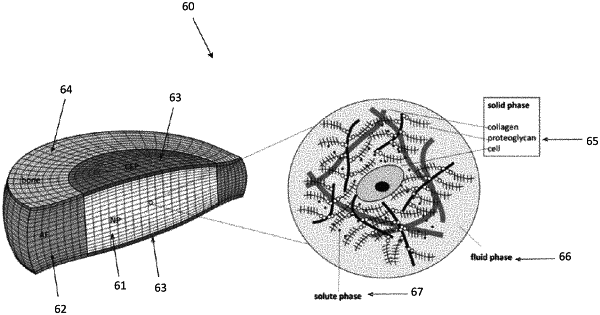| CPC G16H 50/50 (2018.01) [G06F 30/20 (2020.01); G16H 15/00 (2018.01); G16H 50/20 (2018.01); G16H 50/30 (2018.01); G16H 70/60 (2018.01); G06F 2111/04 (2020.01)] | 20 Claims |

|
1. A method for simulating the pathophysiology of intervertebral discs, the method, to be performed by at least one processor disposed in connection with a memory, comprising:
disposing an anatomic database and a biophysical model in connection with a simulation program, the biophysical model comprising a plurality of subsystems;
selecting a defined geometry from the anatomic dataset;
discretizing the biophysical model over the defined geometry;
defining the plurality of subsystems to comprise boundary conditions configured to be progressively altered to generate disc degeneration cascades, said boundary conditions comprising a first boundary condition and a second boundary condition;
defining the plurality of subsystems to further comprise constitutive equations configured to be selectively defined to change the material properties and cell metabolic activities of the intervertebral disc;
selectively applying said first boundary condition and said second boundary condition to said biophysical model to simulate in vivo conditions, said first boundary condition comprising a Neumann boundary condition and said second boundary condition comprising a Dirichlet boundary condition, said first boundary condition and said second boundary condition each applied to a solid phase, fluid phase, and solute phase defined by said anatomic dataset such that:
when said anatomic dataset defines a native intervertebral disc, said first boundary condition and said second boundary condition define the outer surface of the annulus fibrosis and the interface between the cartilaginous endplates and the vertebra;
when said anatomic dataset defines an engineered intervertebral disc, said first boundary condition and said second boundary condition define the culture conditions;
computing at least one solution using the simulation program;
returning pathophysiological metrics according to the at least one solution; and
displaying the pathophysiological metrics.
|